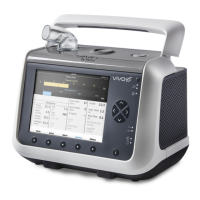Risk of Constriction
Entanglement with cables or tubing constricting airways may cause asphyxiation.
Do not leave long lengths of air tubing or cables around the top of the bed. They
could twist around the patient’s head or neck while sleeping.
The ventilator is equipped with a rebreathing alarm. The alarm is not a substitute for
operator vigilance in ensuring that the leakage port remains clear at all times. Periodi-
cally check the patient circuit during therapy.
In general, as pressure decreases, the potential of rebreathing increases. Lower pres-
sures produce less flow through the leakage port which may not clear all CO
2
from
the circuit to prevent rebreathing.
Risk of Excessive Carbon Dioxide
Insufficient carbon dioxide removal may cause arterial acidemia.
For reducing the risk of rebreathing CO
2
, make sure that the leakage port is located
as near the patient interface as possible. This is even more important for treatments
with low pressure, as this reduces the flow through the leakage port.
WARNING!
Risk of Cross-Contamination
Patient circuits might get contaminated by exhaled gases. To avoid cross-contamina-
tion, always use a properly cleaned or a new patient circuit when the Vivo 45 is to be
used by a new patient.
NOTE
For masks and accessories, always follow the manufacturer’s instructions.
2.5 Usage of Filters
WARNING!
Always use the ventilator with patient air inlet filters installed. Only use the ventilator
with accessories recommended by Breas Medical.
Safety Information 23
Doc. 006149 D-3
Vivo 45 User manual

